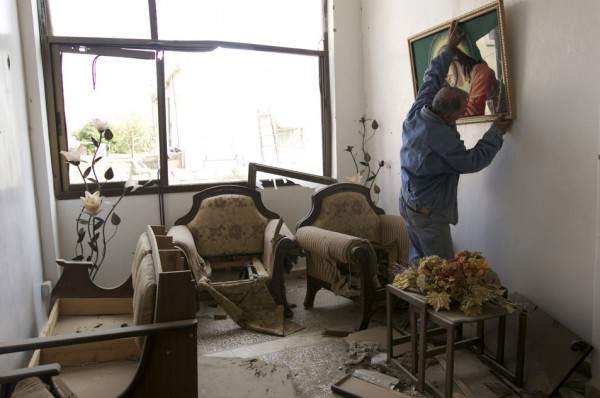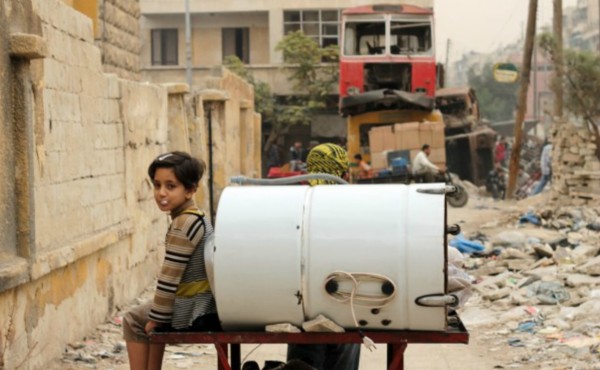Notes
Syria Ho-Hum
The Civil War in Syria rages on. More than 100,000 have died by so-called “conventional means,” plus however many thousands more by chemical means. Horrific images abound of bombs exploding, burned out buildings and vehicles aflame, child warriors, tortured and dead bodies, random limbs strewn about and more. In some ways, however, the most disturbing images are not those that put the conflict on display in all of its goriest details, but rather those photographs that slip through to show a society that seems to have accommodated itself to the war as if it were a normal and ordinary event.
The photograph above is from the north of Syria near the Turkish border in the city of Ras al-Ain. According to the caption his living room has been “damaged” by an attack perpetrated by Kurdish militia and we see him rehanging a painting of Jesus Christ on his wall. It would be easy to make a good deal out of the iconography of Jesus as we view this conflict from the Christian West, but there is a different and more subtle point to be made. Buildings are “damaged” by storms and floods and earthquakes and fires; although there are exceptions, these are typically natural phenomenon over which humans have little if any control. Often they cannot be anticipated or predicted with any precision, and their main effects are primarily material and economic. War, of course, is different. No less physically disastrous than natural phenomena, its effects are as much psychic—if indeed not more so—as they are corporeal. Such psychic trauma is often difficult to see, marked usually in images of demonstrable grief or the now famous “thousand yard stare.” Or as in the image above, it can be altogether invisible, made to appear as part of the natural, ordinary business of cleaning up as if after a storm or an earthquake. Yeah, sure, there was a mortar attack. But now we just fix the windows, pick up the furniture, put the painting back on the wall and go about our day.
The point is driven home by the photograph below of a father and daughter making their way through the city of Aleppo on a cart. The caption says that they are in the process of
migrating from the war torn city. The physical effects of the war are present everywhere, from the rubble that covers the alleyway to the burned out bus stacked on top of another vehicle in the background. But what makes the photograph so potentially disturbing—horrifying even—is that no one seems to notice. The father and daughter make their way through the city without any sense of distress or particular attention to the ruins that surround them. Others go about their business as well, apparently unimpeded by the physical destruction. It is just another day in Aleppo. Indeed, the young girl seems more interested in the person taking the photograph than anything else in her environment, a sign no doubt that she has fully incorporated the apocalyptic state of war into her consciousness as an ordinary and everyday event barely worth paying attention to. The caption underscores the point, noting that she is “blow[ing] a bubble” as if to signal that she really doesn’t have a care in the world.
The real horror of war may well be the way in which those in its midst are forced to assimilate to its damage and destruction as a function of the sheer everydayness of ordinary life. The real horror of war, in other words, may well lie in the ways in which its effects are invisible to the naked eye. And that is what photographs can often put on display.
— John Lucaites
(cross-posted from No Caption Needed)
(photo 1: Ras al-Ain/Reuters; photo 2: Karam al-Masric/AFP/Getty Images)




Reactions
Comments Powered by Disqus